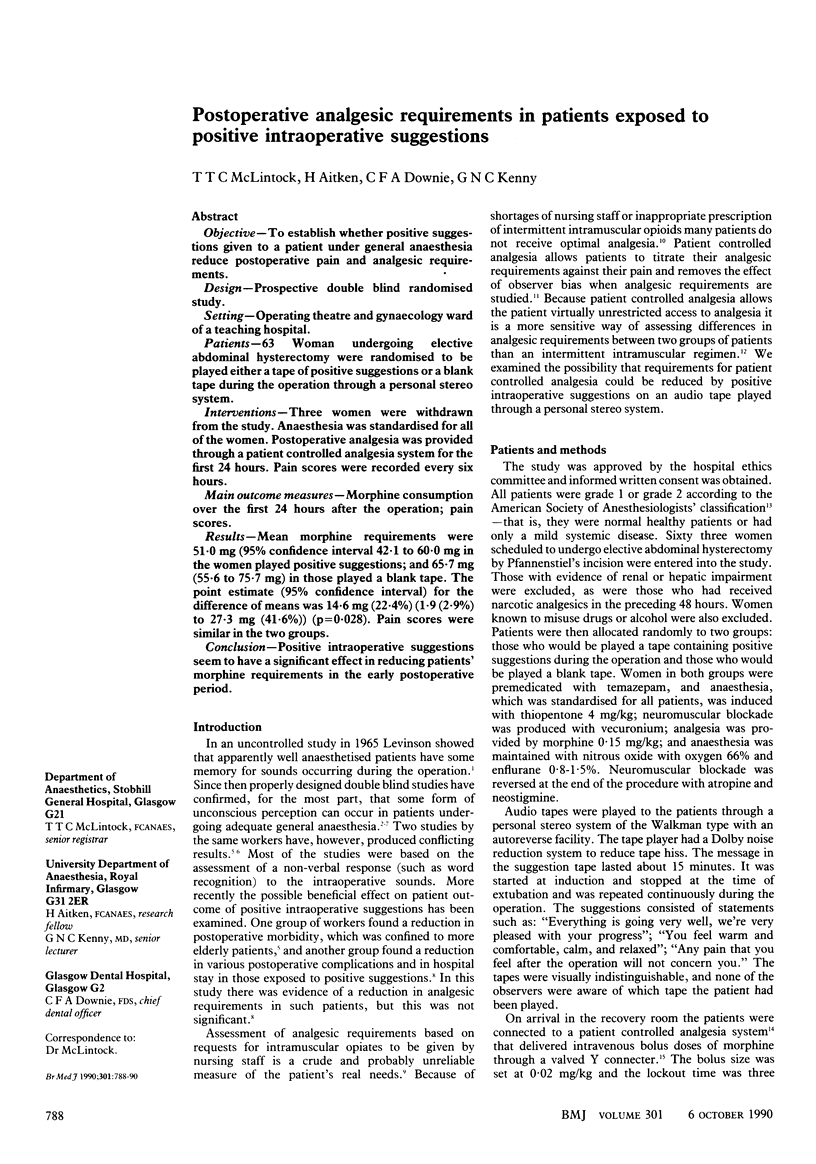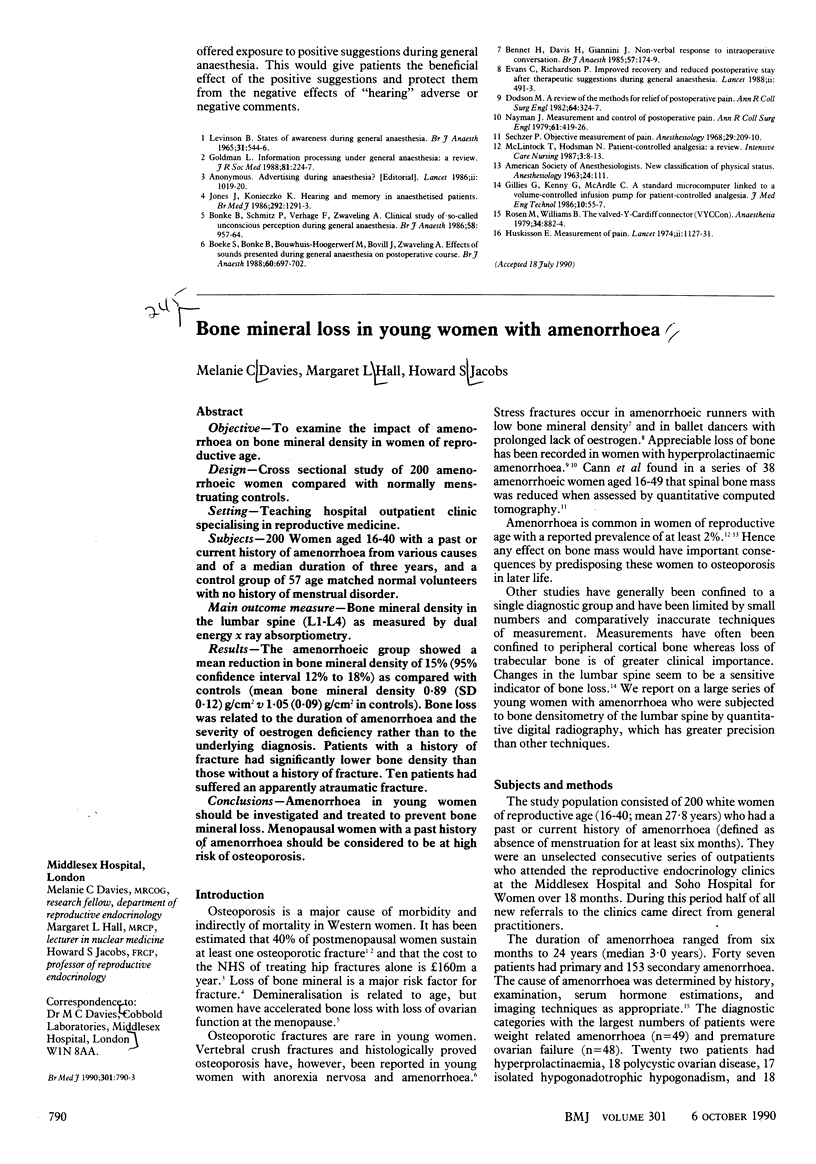Abstract
OBJECTIVE--To establish whether positive suggestions given to a patient under general anaesthesia reduce postoperative pain and analgesic requirements. DESIGN--Prospective double blind randomised study. SETTING--Operating theatre and gynaecology ward of a teaching hospital. PATIENTS--63 Woman undergoing elective abdominal hysterectomy were randomised to be played either a tape of positive suggestions or a blank tape during the operation through a personal stereo system. INTERVENTIONS--Three women were withdrawn from the study. Anaesthesia was standardised for all of the women. Postoperative analgesia was provided through a patient controlled analgesia system for the first 24 hours. Pain scores were recorded every six hours. MAIN OUTCOME MEASURES--Morphine consumption over the first 24 hours after the operation; pain scores. RESULTS--Mean morphine requirements were 51.0 mg (95% confidence interval 42.1 to 60.0 mg in the women played positive suggestions; and 65.7 mg (55.6 to 75.7 mg) in those played a blank tape. The point estimate (95% confidence interval) for the difference of means was 14.6 mg (22.4%) (1.9 (2.9%) to 27.3 mg (41.6%] (p = 0.028). Pain scores were similar in the two groups. CONCLUSION--Positive intraoperative suggestions seem to have a significant effect in reducing patients' morphine requirements in the early postoperative period.
Full text
PDF


Selected References
These references are in PubMed. This may not be the complete list of references from this article.
- Bennett H. L., Davis H. S., Giannini J. A. Non-verbal response to intraoperative conversation. Br J Anaesth. 1985 Feb;57(2):174–179. doi: 10.1093/bja/57.2.174. [DOI] [PubMed] [Google Scholar]
- Boeke S., Bonke B., Bouwhuis-Hoogerwerf M. L., Bovill J. G., Zwaveling A. Effects of sounds presented during general anaesthesia on postoperative course. Br J Anaesth. 1988 May;60(6):697–702. doi: 10.1093/bja/60.6.697. [DOI] [PubMed] [Google Scholar]
- Bonke B., Schmitz P. I., Verhage F., Zwaveling A. Clinical study of so-called unconscious perception during general anaesthesia. Br J Anaesth. 1986 Sep;58(9):957–964. doi: 10.1093/bja/58.9.957. [DOI] [PubMed] [Google Scholar]
- Dodson M. E. A review of methods for relief of postoperative pain. Ann R Coll Surg Engl. 1982 Sep;64(5):324–327. [PMC free article] [PubMed] [Google Scholar]
- Evans C., Richardson P. H. Improved recovery and reduced postoperative stay after therapeutic suggestions during general anaesthesia. Lancet. 1988 Aug 27;2(8609):491–493. doi: 10.1016/s0140-6736(88)90131-6. [DOI] [PMC free article] [PubMed] [Google Scholar]
- Huskisson E. C. Measurement of pain. Lancet. 1974 Nov 9;2(7889):1127–1131. doi: 10.1016/s0140-6736(74)90884-8. [DOI] [PubMed] [Google Scholar]
- Jones J. G., Konieczko K. Hearing and memory in anaesthetised patients. Br Med J (Clin Res Ed) 1986 May 17;292(6531):1291–1293. doi: 10.1136/bmj.292.6531.1291. [DOI] [PMC free article] [PubMed] [Google Scholar]
- McLintock T. T., Hodsman N. B. Patient-controlled analgesia. Intensive Care Nurs. 1987;3(1):8–13. doi: 10.1016/0266-612x(87)90004-6. [DOI] [PubMed] [Google Scholar]
- Nayman J. Measurement and control of postoperative pain. Ann R Coll Surg Engl. 1979 Nov;61(6):419–426. [PMC free article] [PubMed] [Google Scholar]
- Rosen M., Williams B. The Valved-Y-Cardiff Connector (V.Y.C. Con). Anaesthesia. 1979 Oct;34(9):882–884. doi: 10.1111/j.1365-2044.1979.tb08540.x. [DOI] [PubMed] [Google Scholar]


